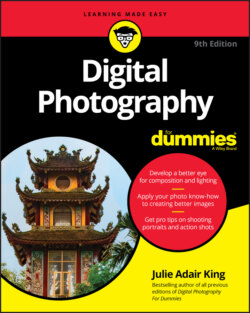Читать книгу Digital Photography For Dummies - King Julie Adair, Julie Adair King - Страница 27
Lens aperture range
ОглавлениеThe aperture is an adjustable hole through which light must pass to reach the image sensor. Aperture size is stated in f-numbers, more commonly referred to as f-stops. A higher number indicates a narrower aperture size. So f/11, for example, results in a smaller aperture opening than f/8.
Changing the aperture size is one way to manipulate exposure. But the f-stop setting also contributes to depth of field, or the distance over which focus appears sharp. The smaller the aperture, the greater the depth of field, as illustrated in Figure 1-10. The background is much sharper in the left image, taken with an f-stop of f/22, compared with the right image, shot at f/6.3.
If you're keeping track, you now know that the lens gives you two points of control over depth of field: the focal length and the aperture setting. In Figure 1-10, I used the same focal length for each shot, so the aperture setting is the sole reason for the shift in depth of field.
FIGURE 1-10: For the left image, I set the aperture to f/22; for the right image, f/6.3.
And why, you're probably wondering, is the exposure of both images in Figure 1-10 the same, given what I just said about the f-stop affecting image brightness? This is why: To compensate for opening the aperture to f/6.3, I reduced the exposure time by changing the shutter speed from 1/320 of a second to 1/4000 of a second, so the light was able to strike the image sensor for a shorter period. I kept the ISO setting (light sensitivity) at ISO 400 for both photos.
You can explore f-stops, exposure, and depth of field further in Part 2 of the book. For the purpose of comparing lenses, you need just a few more bits of aperture information:
Every lens has a specific range of aperture settings. Obviously, the larger that range, the more control you have as a photographer.
The larger the maximum aperture, the “faster” the lens. Again, the more open the aperture becomes, the less time is needed to expose the image. So if one lens can open to a maximum setting of f/4 and another lens has a maximum aperture of f/2, the f/2 version is said to be faster. A fast lens is especially beneficial when photographing action, because a moving subject blurs at long exposure times. But it also helps when you shoot in dim lighting, because you can get the shot at a lower ISO setting, reducing the chances of image noise. That very low f-stop also enables you to produce images that have a very shallow depth of field when your creative vision demands it.
On a zoom lens, the aperture range may change as you zoom in or out. For example, on an 18–140mm lens, you may be able to open the aperture to f/2 when the lens is at the 18mm position but only to f/5.6 at 140mm. You can buy zoom lenses that maintain the same minimum and maximum apertures throughout the zoom range, but be prepared to part with more money than for a lens that doesn't offer this feature.
Depth of field at any aperture varies depending on the size of the image sensor and lens. Cameras with small sensors and lenses produce a much greater depth of field at any f-stop than cameras with larger sensors and lenses. The result is that it can be difficult to achieve much background blurring even if you open the aperture all the way. That's an important consideration if you're interested in the type of photography that benefits from a short depth of field, such as portraiture. On the other hand, if you're a landscape photographer, you may love the extended depth of field those smaller sensors and lenses produce.
